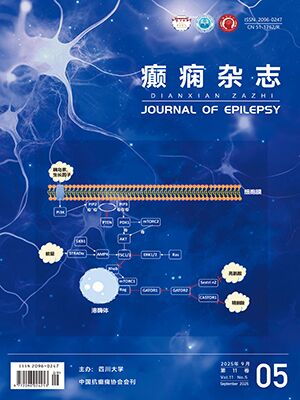| 1. |
Hirtz D, Thurman DJ, Gwinn-Hardy K, et al. How common are the common neurologic disorders? Neurology, 2007, 68(5): 326-337.
|
| 2. |
Brodie MJ, Dichter MA. Antiepileptic drugs. N Engl J Med, 1996, 334(3): 168-175.
|
| 3. |
中国抗癫痫协会. 临床诊疗指南•癫痫病学分册(2023修订版). 北京: 人民卫生出版社, 2015: 1-151.
|
| 4. |
He Z, Li J. The therapeutic effects of lacosamide on epilepsy-associated comorbidities. Front Neurol, 2023, 14: 1063703.
|
| 5. |
Driessen JT, Wammes-van der Heijden EA, Verschuure P, et al. Effectiveness and tolerability of lacosamide in children with drug resistant epilepsy. Epilepsy Behav Rep, 21: 100574.
|
| 6. |
Zhao T, Yu LH, Zhang HL, et al. Long-term effectiveness and safety of lacosamide as adjunctive therapy in children and adolescents with refractory epilepsy: a real-world study. BMC Pediatr, 2023, 23(1): 249.
|
| 7. |
Kwan P, Arzimanoglou A, Berg AT, et al. Definition of drug resistant epilepsy: consensus proposal by the ad hoc Task Force of the ILAE Commission on Therapeutic Strategies. Epilepsia, 2010, 51(6): 1069-1077.
|
| 8. |
Wilson SM, Khanna R. Specific binding of lacosamide to collapsin response mediator protein 2 (CRMP2) and direct impairment of its canonical function: implications for the therapeutic potential of lacosamide. Mol Neurobiol, 2015, 51(2): 599-609.
|
| 9. |
张鹤声, 张恩惠, 刘文钰, 等. 拉考沙胺单药治疗癫痫发作的研究进展. 中国新药与临床杂志, 2022, 41(2): 79-84.
|
| 10. |
Pasha I, Kamate M, Suresh DK. Safety of lacosamide in children with refractory partial epilepsy. Saudi Pharm J, 2015, 23(5): 556-61.
|
| 11. |
Romoli M, Mazzocchetti P, D'Alonzo R, et al. Valproic acid and epilepsy: from molecular mechanisms to clinical evidences. Curr Neuropharmacol, 2019, 17(10): 926-946.
|
| 12. |
王婷, 杨文秋, 余彦萤, 等. 左乙拉西坦的药物基因组学与疗效预测研究进展. 中华神经科杂志. 2021, 54(9): 973-978.
|
| 13. |
Ambrósio AF, Soares-Da-Silva P, Carvalho CM, et al. Mechanisms of action of carbamazepine and its derivatives, oxcarbazepine, BIA 2-093, and BIA 2-024. Neurochem Res, 2002, 27(1-2): 121-130.
|
| 14. |
de Biase S, Valente M, Gigli GL, et al. Pharmacokinetic drug evaluation of lacosamide for the treatment of partial-onset seizures. Expert Opin Drug Metab Toxicol, 2017, 13(9): 997-1005.
|
| 15. |
冯杰, 高丽, 李岩, 等. 拉考沙胺在儿童难治性癫痫添加治疗的临床效果观察. 癫痫杂志, 2020, 6(2): 98-101.
|
| 16. |
Ortiz de la Rosa JS, Ladino LD, Rodríguez PJ, et al. Efficacy of lacosamide in children and adolescents with drug-resistant epilepsy and refractory status epilepticus: a systematic review. Seizure, 2018, 56: 34-40.
|
| 17. |
Miskin C, Khurana DS, Valencia I, et al. Efficacy and tolerability of lacosamide in the treatment of children with refractory generalized epilepsy. J Child Neurol, 2016, 31(7): 925-928.
|
| 18. |
Zhou R, Qu R, Liu M, et al. Perampanel and lacosamide monotherapy in pediatric patients with newly diagnosed focal epilepsy: a prospective study evaluating efficacy, tolerability, and behavior. Epilepsy Behav, 2023, 146: 109353.
|
| 19. |
Driessen JT, Wammes-van der Heijden EA, Verschuure P, et al. Effectiveness and tolerability of lacosamide in children with drug resistant epilepsy. Epilepsy Behav Rep, 2023, 21: 100574.
|
| 20. |
Lu YT, Lin CH, Ho CJ, et al. Evaluation of cardiovascular concerns of intravenous lacosamide therapy in epilepsy patients. Front Neurol, 2022, 13(7): 891368.
|




